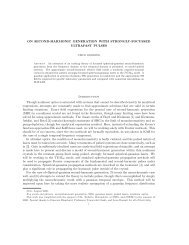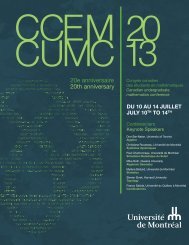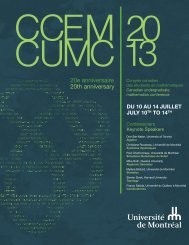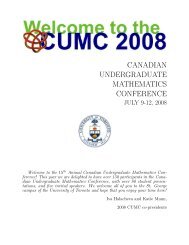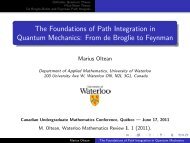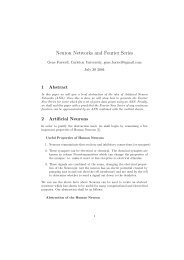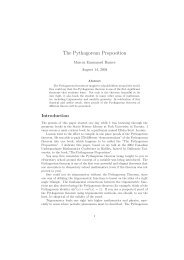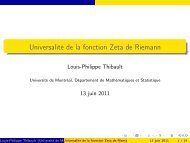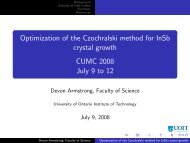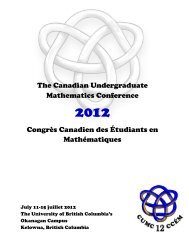Student Talks: Titles and Abstracts - CUMC
Student Talks: Titles and Abstracts - CUMC
Student Talks: Titles and Abstracts - CUMC
Create successful ePaper yourself
Turn your PDF publications into a flip-book with our unique Google optimized e-Paper software.
C a n a dia n U n dergra d u ate M a t he m atics C o nfere nce<br />
C arleto n U niversity<br />
O tta w a O n<br />
July 8 – 1 1, 2 0 0 9<br />
The Canadian Undergraduate Mathematics Conference is an annual event hosted by a<br />
different Canadian university each year. It is aimed at students interested in<br />
mathematics <strong>and</strong> related fields, including physics, statistics, bio-informatics,<br />
economics, finance, <strong>and</strong> computer science. In 2006, the 13 th edition of the <strong>CUMC</strong><br />
became a truly international conference for the first time, welcoming students who<br />
attend universities outside of Canada. While the principle organizers <strong>and</strong> majority of<br />
participants at the <strong>CUMC</strong> are undergraduate students, anyone may participate <strong>and</strong><br />
present a talk aimed at undergraduates. As well, keynote speakers ranging from<br />
professional mathematicians to individuals whose careers are deeply intertwined with<br />
mathematics, will form an integral part of the <strong>CUMC</strong> experience.<br />
The <strong>CUMC</strong> is an opportunity for students to explore mathematics outside their usual<br />
surroundings <strong>and</strong> to develop an interest in areas they have not yet been exposed to.<br />
The conference also provides a unique chance for students to present what they find<br />
most fascinating in mathematics, <strong>and</strong> to hone their expository skills in a supportive,<br />
non-competitive environment. Indeed, the core of the conference consists of a series of<br />
talks given by the participants, on topics completely of their choosing. The <strong>CUMC</strong> is a<br />
unique opportunity for Canadian undergraduates to not only learn mathematics, but to<br />
experience <strong>and</strong> do mathematics.<br />
W elc o me T o C arleto n U niversity<br />
H o m e of C U M C 2 0 0 9<br />
Welcome to the 16 th Annual <strong>CUMC</strong>! This year we have 6 keynote speakers, 100+ participants from all<br />
over Canada, <strong>and</strong> 60+ student talks. From all of us on the organization committee, Welcome to<br />
Carleton!<br />
C u m c 2 0 0 9 O r g a nizing C o m mittee<br />
Gary Bazdell<br />
David Thomson<br />
Helen Colterman<br />
Alex Weekes<br />
Shirin Roshanafshar<br />
Christina Kevins<br />
Jenna Tattersall<br />
Stephanie Cates
Keynote Speakers: Talk <strong>Titles</strong> <strong>and</strong> <strong>Abstracts</strong><br />
Création de données synthétiques: Expérience de Statistique Canada à partir du Cross National<br />
Equivalent File<br />
Cynthia Bocci<br />
Statistical Society of Canada<br />
Depuis 15 ans, la création de données synthétiques comme méthode de protection du secret<br />
statistique a gagné en popularité. Depuis peu, Statistique Canada étudie les possibilités de cette<br />
approche par rapport aux données canadiennes du Cross National Equivalent File (CNEF). Le CNEF<br />
est composé de sous-ensembles de six enquêtes par panel, qui comporte des variables sur l'emploi et<br />
le revenu définies de façon similaire. Le volet canadien du CNEF est un sous-ensemble de variables<br />
provenant de l'Enquête sur la dynamique du travail et du revenu (EDTR). Étant donné les exigences<br />
relatives à la confidentialité, au Canada, il faut obtenir une permission spéciale de Statistique Canada,<br />
pour accéder aux données de ce volet, alors que les données recueillies par les universités ou les<br />
instituts privés ne font pas l'objet de telles restrictions. Ce faisant, les données canadiennes sont<br />
souvent exclues des analyses. S'il en existait une version synthétique, il serait plus facile d'accéder à<br />
ces données et, par conséquent, de les utiliser.<br />
Dans cette présentation, nous décrivons la méthodologie employée pour créer les données<br />
synthétiques du volet canadien du CNEF. Nous nous penchons également sur le défi qui consiste créer<br />
des ménages cohérents - qui conservent autant que possible les relations des données originales -<br />
tout en maintenant le risque de divulgation au plus bas. Enfin, cette présentation présente des<br />
résultats transversaux.<br />
Geometric Graph Spanners<br />
Prosenjit Bose<br />
Carleton University<br />
A geometric graph is a graph whose vertices are points in the plane <strong>and</strong> whose edges are line<br />
segments joining the points. The weight of an edge is usually defined as its length. Informally, a<br />
spanner of a geometric graph G is a subgraph H that "approximates" G. The challenge in constructing<br />
spanners stems directly from what it means to approximate a graph <strong>and</strong> how we measure this<br />
approximation. A st<strong>and</strong>ard measure of approximation is to insist that for every edge xy in G, there is a<br />
path in H from x to y whose total length is not too much more than the length of the edge xy. In this talk,<br />
we will present an overview of various spanner construction techniques.
Les Chaussettes de M. Bertlmann Révisiter:<br />
A Short History of Quantum Mechanics <strong>and</strong> the Einstein-Podolsky-Rosen Argument<br />
Robb Fry<br />
Thompson Rivers University<br />
We give a brief account of the origins <strong>and</strong> basic principles of quantum mechanics, concluding with<br />
a description of the famous EPR example.<br />
The Mathematics of Public-Key Cryptography<br />
David Jao<br />
University of Waterloo<br />
The art of cryptography, or encryption, has in modern times undergone a profound transformation from<br />
a trial <strong>and</strong> error process into a systematic field of study. To a large extent, this change has been<br />
brought about by the introduction <strong>and</strong> integration of concepts from pure mathematics. This talk surveys<br />
a small portion of this evolution, by describing how number theory <strong>and</strong> algebraic geometry have<br />
contributed to the development of public key cryptography. Along the way, we provide a classification<br />
of curves in cryptography <strong>and</strong> explain why genus 1 curves (also known as elliptic curves) seem to<br />
provide the best possible security among all of the possible families of algebraic curves used in<br />
cryptography.<br />
What Is A Zeta Function?<br />
Ram Murty<br />
Queens University<br />
We will give a brief survey of zeta functions, their use <strong>and</strong> some of the open questions regarding their<br />
special values.<br />
So You Want To Go To Grad School<br />
Colin Weir<br />
University of Calgary<br />
With the economy being what it is, more <strong>and</strong> more people are putting off entering the job market (what<br />
grad students call 'the real world') in favour of furthering their education. Whether or not this is your<br />
motivation, deciding to go to grad school can be a big decision <strong>and</strong> a very involved process. The<br />
purpose of this talk is to discuss the particulars of grad school that everyone seems to expect you to<br />
know <strong>and</strong> yet nobody ever tells you about... until now. To this end, I have the humble goal of addressing<br />
all of the questions that you didn't even know you had, <strong>and</strong> hopefully some of those that you do.
<strong>Student</strong> <strong>Talks</strong>: <strong>Titles</strong> <strong>and</strong> <strong>Abstracts</strong><br />
The Merit Factor Problem<br />
Navid Alaei<br />
Simon Fraser<br />
In this presentation we will introduce the Merit Factor Problem or equivalently the problem of minimizing<br />
the L4 norm of Littlewood polynomials on the boundary of the unit circle of the complex plane. We first<br />
give a historical background of the problem <strong>and</strong> then present some of the ongoing research <strong>and</strong> results.<br />
These include practical <strong>and</strong> theoretical motivations <strong>and</strong> also an overview of computational <strong>and</strong><br />
theoretical approaches taken towards solving this classical, yet challenging problem.<br />
The prerequisites are: some elementary number theory <strong>and</strong> analysis.<br />
A geometric realization of the irreducible representations of GL_n(C)<br />
Faisal Al-Faisal<br />
University of Waterloo<br />
In this talk I will give an example showing how algebraic geometry can be used in representation<br />
theory. Specifically, we will look at the polynomial representations of GL_n(C) <strong>and</strong> see how all the<br />
irreducible ones can be realized as sections of a special algebraic line bundle. This is the first step<br />
towards underst<strong>and</strong>ing what the Borel-Bott-Weil theorem says about reductive algebraic groups (of<br />
which GL_n(C) is an example).<br />
To make the talk as accessible as possible, I will explain what is meant by such terms as<br />
"representation", "line bundle", "algebraic group", etc.<br />
A Visualization Tool for 3-Dimensional System of Differential Equations in Maple<br />
Yuanxun Bill Bao<br />
Simon Fraser<br />
System of differential equations(DEs) plays an essential role in the study of dynamical systems <strong>and</strong><br />
mathematical modelling. An important tool for studying system of DEs is using the directional field. The<br />
directional field gives a graphical representation of the behaviour of the system without solving it<br />
analytically. In this talk, we present some new options to DEplot3d comm<strong>and</strong> in Maple, which solves a<br />
3-dimensional system of DEs numerically <strong>and</strong> plot the solution curve(s). In an effort to enhance the<br />
visualization of the system, we create the directional field using a set of 3D arrows <strong>and</strong> provide<br />
animations for the directional field so that the dynamics of each point are well captured. We will also<br />
give some examples of interesting dynamical systems using this new visualization tool.
Tensor product <strong>and</strong> Schmidt decomposition<br />
Farzin Barekat<br />
UBC<br />
We begin by talking about spectral theorem, polar decomposition <strong>and</strong> singular value decomposition,<br />
which are some very famous <strong>and</strong> useful results in linear algebra. We then introduce tensor product of<br />
two vector spaces <strong>and</strong> some of the basic facts about this construction. Tensor product is ubiquitous in<br />
many different fields of mathematics <strong>and</strong> physics. We conclude the talk by proving Schmidt<br />
decomposition using the above theorems <strong>and</strong> concepts.<br />
No knowledge of any of the above will be assumed.<br />
Trapped Surfaces<br />
Michael Barriault<br />
Memorial University<br />
In this talk I give a brief overview of mathematical definitions of black hole boundaries, specifically<br />
apparent horizons <strong>and</strong> the event horizon, <strong>and</strong> discuss on how the concepts differ. Some core concepts<br />
of n-dimensional surfaces will be introduced, <strong>and</strong> then how they relate to finding horizons. Industrial<br />
applications of apparent horizons will be discussed, as well as a few examples. This talk will be<br />
primarily conceptual <strong>and</strong> visual in nature, <strong>and</strong> a background in general relativity or differential geometry<br />
will not be required nor expected.<br />
An adaptive Newton's method for root solving (in English with French slides)<br />
Une méthode de Newton adaptative pour trouver les zéros d'une fonction (en anglais avec diapos en<br />
français)<br />
Rosalie Bélanger-Rioux<br />
McGill<br />
Newton's method is a root-finding method which appears to behave chaotically when used on certain<br />
functions or systems of equations F, that is, it does not always converge to the "correct" root. This<br />
method tries to follow the solution curve of an ODE related to the system of equations F. In fact, it tends<br />
to take large steps, in order to get fast convergence. The problem is when the method takes too large a<br />
step <strong>and</strong> "switches" solution curves, eventually converging to a different zero of F. To eliminate this<br />
unwanted behavior, we use adaptivity. In this talk I will present the concept of adaptivity, show how I<br />
applied it to Newton's Method as a summer research project , <strong>and</strong> show some pretty pictures with<br />
fractals... <strong>and</strong> some others with no fractals!<br />
La méthode de Newton permet de trouver efficacement les zéros d'un système d'équations F.<br />
Cependant, cette méthode agit parfois de façon chaotique, c'est-à-dire qu'elle ne converge pas<br />
nécessairement vers le “bon” zéro. Ceci est causé par le fait que la méthode de Newton tente de suivre<br />
la courbe de solution d'un système d'EDO relié à F, en faisant de gr<strong>and</strong>s pas pour obtenir une<br />
convergence rapide. Un problème survient qu<strong>and</strong> la méthode prend un trop gr<strong>and</strong> pas et tombe sur un<br />
autre type de courbe de solution, trouvant ainsi un “mauvais”zéro. Afin d'enrayer ce problème, on peut<br />
utiliser l'adaptativité. Lors de cette présentation, j'introduirai le concept d'adaptativité, pour ensuite<br />
l'appliquer à la méthode de Newton (travail fait durant un projet de recherche en été). J'aurai tout plein<br />
de jolies images avec des fractales, et sans fractales, à vous montrer!
Frequentist <strong>and</strong> Bayesian interval estimation<br />
Ana Best<br />
McGill<br />
In the area of interval estimation, as in many areas of statistics, Frequentist <strong>and</strong> Bayesian methods<br />
seem to be wildly different <strong>and</strong> often at odds with one another. The sources of probability statements<br />
about confidence intervals <strong>and</strong> credibility intervals are very different, <strong>and</strong> lead to seemingly opposing<br />
interpretations of these two concepts.<br />
In this talk, I will explain the concepts underlying both Frequentist <strong>and</strong> Bayesian interval estimation <strong>and</strong><br />
clarify the points of confusion with regard to their interpretations. I will also emphasize the differences<br />
between the two paradigms. Finally, I will introduce a third way of looking at interval estimation,<br />
introduced by Jerzy Neyman (the "father" of the Frequentist confidence interval), which combines<br />
elements of both the Frequentist <strong>and</strong> Bayesian methods, <strong>and</strong> I will show how this relates, in particular,<br />
to the Frequentist confidence interval.<br />
Prerequisites: Basic courses in probability <strong>and</strong>/or statistics: A rudimentary underst<strong>and</strong>ing of r<strong>and</strong>om<br />
variables, probability distribution functions, <strong>and</strong> Bayes' Theorem.<br />
Problem solving with graphs <strong>and</strong> matrices<br />
Natalie Campbell<br />
Redeemer University College<br />
When you look at a system of equations, you often want to know how it works in general, not only for a<br />
specific example. This enables the system to be applied to the world in general, as opposed to a single<br />
occurrence. One of the ways we obtain information about a system is to look at the eigenvalues of the<br />
corresponding matrix. But how do we do this when we don't know the specifics? We will discuss various<br />
ways graph theory <strong>and</strong> linear algebra work together to find answers to this <strong>and</strong> other problems.<br />
Knowledge of Linear algebra is assumed, while knowledge of Graph theory is not.<br />
An introduction to Fractal Geometry<br />
Vincent Chan<br />
Waterloo<br />
We will explore a small portion of fractal geometry, focusing on a discussion of the Hausdorff measure<br />
<strong>and</strong> dimension, some examples, <strong>and</strong> a nice theoretic application. Background in measure theory would<br />
help, but is not required.
Card Shuffling<br />
Helen Colterman<br />
Carleton University<br />
How often does one have to shuffle a deck of cards until it is r<strong>and</strong>om? Diaconis, a magician turned<br />
mathematician, was especially concerned with this question. After specifying the size of the deck<br />
(n=52), choosing how we shuffle (we will analyze top-in-at-r<strong>and</strong>om shuffles first <strong>and</strong> then the more<br />
effective riffle shuffles), <strong>and</strong> explaining what is meant by “r<strong>and</strong>om” or “close to r<strong>and</strong>om”, we will obtain<br />
an upper bound of 12 riffle shuffles. Leading up to this finding, we make use of some well-formed ideas:<br />
the concepts of stopping rules <strong>and</strong> of “strong uniform time”, the lemma that strong uniform time bounds<br />
the variation distance, Reed’s inversion lemma, <strong>and</strong> thus the interpretation of shuffling as “reversed<br />
sorting”. Ultimately, we will reduce everything to a pair of classical combinatorial problems, namely the<br />
coupon collector <strong>and</strong> the birthday paradox, to achieve our upper bound.<br />
Grassmannians <strong>and</strong> Enumerative Geometry<br />
Peter Crooks<br />
Dalhousie University<br />
We will introduce complex projective space, CP^n, <strong>and</strong> realize it as an n-dimensional compact complex<br />
analytic manifold. A subsequent introduction to complex Grassmannians <strong>and</strong> the Plucker Embedding<br />
will take place <strong>and</strong> culminate with the imposition of a compact complex manifold structure on<br />
Grassmannians. Time-permitting, one or both of two solutions to a classical intersection-theoretic<br />
problem in enumerative geometry will be given.<br />
Familiarity with basic general topology, basic exterior algebra, <strong>and</strong> the notion of a differentiable<br />
manifold will prove advantageous. The presentation will not presuppose any degree of familiarity with<br />
homology <strong>and</strong> cohomology. However, prior exposure to these concepts might be somewhat useful<br />
during a small portion of the presentation.<br />
R<strong>and</strong>omized algorithms<br />
Victor Fan<br />
Waterloo<br />
An overview of the some of the most clever r<strong>and</strong>omized algorithms <strong>and</strong> their expected run-time<br />
analyses. (Talk prerequisite: basic run-time analysis of pseudocode; no programming experience<br />
needed.) Here are some questions to stir your interest. How fast can you find the median of 2n+1<br />
distinct numbers? (You may know the classic worst-case O(n) algorithm, but that algorithm is boring;<br />
we will look at a different one.) Given a vertex-weighted graph having n vertices, all of which have<br />
degree 3 or less, how does one use r<strong>and</strong>omization to find a local minimum (a vertex with weight less<br />
than all its neighbours) in expected o(n) time? (This means we don't even expect to look at all the<br />
vertices! :O )
The Casimir Effect <strong>and</strong> High-Temperature Superconductors<br />
Simon Foreman<br />
UBC<br />
Superconductivity (the disappearance of electrical resistance within a material below a certain critical<br />
temperature) <strong>and</strong> the Casimir effect (a physical force that is a consequence of quantum vacuum<br />
fluctuations) are at first glance unrelated. I will provide introductions to each phenomenon, <strong>and</strong> then<br />
discuss recent work that proposes an intimate connection between the two, based (in brief) on the<br />
energy scales involved. If correct, this proposal promises important insights into the behaviour of hightemperature<br />
superconductors—I will conclude by reviewing tentative results in this direction.<br />
Fractals in complex dynamics: A presentation with pictures!<br />
Jérôme Fortier<br />
Laval University<br />
Anyone who has ever seen a fractal image of a Julia set (if you haven't, Google it!) must have been<br />
astonished by the beauty of the regular irregularity of it. But what, exactly, is a Julia set? The aim of my<br />
talk will be to answer that question, but also, to help you answer the more important one: are the math<br />
behind the pictures as interesting as the pictures themselves are? To help you answer that one, we will<br />
give a short overview of the theory of iteration <strong>and</strong> its generalizations, so that you will be able to answer<br />
that question yourself.<br />
Hint: the answer is Yes.<br />
Integer Partition Identities<br />
Parker Glynn-Adey<br />
Trent<br />
Integer partitions have been an active area of research in additive number theory since the birth of<br />
mathematics. We present some basic aspects of the theory with an emphasis on various proof<br />
techniques used. Several examples will be covered demonstrating the use of generating functions,<br />
Ferrers diagrams, <strong>and</strong> bijective techniques. If time permits recent develops since the 1980s using<br />
automated proofs will be discussed. Introductory talk, no background needed.<br />
Introduction to Tree Augmentation Problem<br />
Krystal Guo<br />
Waterloo<br />
We will define the tree augmentation problem, which is a connectivity problem, where in one tries to<br />
increase the edge-connectivity of some graph by adding as few edges as possible. We will then present<br />
some combinatorial approximation algorithms for the tree augmentation problem. No prior knowledge of<br />
graph theory or approximation algorithms is require.
Zero-Sum Two-Person Games<br />
Kimberly Hart<br />
Queen's University<br />
Game theory is a field within mathematics, <strong>and</strong> one with some interesting applications. This talk will<br />
explore the two-person zero-sum game including the mini-max theorem, Nash equilibrium <strong>and</strong> utility<br />
theory. A course in real analysis would be helpful for some of the notation <strong>and</strong> concepts used in proofs,<br />
but the level of math is suitable for all levels <strong>and</strong> abilities.<br />
The Geometry of Musical Chords<br />
Gina Hochban<br />
University of Regina<br />
Math <strong>and</strong> music have more in common than just the letter "m"! Princeton University’s Dmitri Tymoczko<br />
has given literal shape to music by relating musical chords of n notes to points in an n-dimensional<br />
geometric space - with an attempt at quantifying “good sounding music.” Focusing on the 2-dimensional<br />
case for visual ease, we will construct a familiar orbifold on which every possible 2-note chord resides,<br />
<strong>and</strong> marvel in the curious ability for mathematics to give structure to yet another seemingly intangible<br />
topic!<br />
Gershgorin <strong>and</strong> his circles<br />
Alex Lang<br />
McGill<br />
We will prove a result that was proved by Gershgorin in 1931. The theorem gives some idea about the<br />
location of the eigenvalues of a square matrix. It is very cute <strong>and</strong> elegant <strong>and</strong> turns out to have<br />
interesting applications. We will investigate some of these applications. Only basic knowledge of linear<br />
algebra <strong>and</strong> analysis is required.<br />
I will try to include nice drawings if I have the time.<br />
Control Theory<br />
Jean-Sébastien Lévesque<br />
Laval<br />
Arrow's Impossibility Theorem<br />
Elliott Lipnowski<br />
Waterloo<br />
I will provide a proof of Kenneth Arrow's celebrated theorem in Social Choice Theory (a relative of<br />
Game Theory), which contradicts the existence of an ideal electoral system. The proof is modeled in<br />
such a way that the stronger Gibbard-Satterthwaite theorem can be proven with very little modification.<br />
Weak Topology<br />
Elliott Lipnowski<br />
Waterloo<br />
In this talk, we will study some basic notions <strong>and</strong> propositions regarding the weak topology on Banach<br />
spaces. We will then go on to prove a useful result in Functional Analysis, the Banach-Alaoglu<br />
Theorem.<br />
Prerequisites: Basic Real Analysis.
Modules, Fitting Ideals, <strong>and</strong> Polynomials<br />
Justin Martel<br />
Ottawa U<br />
No doubt modules over arbitrary rings must be understood as fundamental objects in the growing<br />
mathematicians future. With a view towards the future, modules over commutative rings shall be<br />
assumed, <strong>and</strong> a particular sequence of invariants shall be introduced. These Fitting ideals shall move<br />
us towards finite free resolutions of a module, annihilators, <strong>and</strong> primary decompositions. Concrete<br />
realizations of these notions shall be emphasized over polynomial rings. Expect the speaker to appear<br />
quite fond of commutative rings, ideals, <strong>and</strong> modules.<br />
Combinatorics of the Littlewood Richardson Coefficients<br />
Adam McCabe<br />
Queen's University<br />
In this talk I will briefly introduce the Littlewood Richardson Coefficients which arise in the study of<br />
Schur functions as well as the representation theory of the general linear group, <strong>and</strong> the Horn<br />
Conjecture. These coefficients can be calculated in more than one way <strong>and</strong> often involve interesting<br />
<strong>and</strong> creative combinatorial constructions including the Littlewood Richardson rule, <strong>and</strong> the Puzzles<br />
algorithm.<br />
This talk should be fully self contained <strong>and</strong> require no prerequisits.<br />
Generalized Lindemann Theorem <strong>and</strong> the resulting family of transcendental numbers.<br />
Steven McPherson<br />
Waterloo<br />
Convex Analysis as a Method of Proof<br />
Stephen Melczer<br />
Simon Fraser<br />
Over the last decade, Convex Optimization has become a very popular subject in Applied Mathematics<br />
due to advances in the creation of fast <strong>and</strong> reliable solvers. In this talk, we will explore how the<br />
properties of convex sets can be used in an analysis context to prove results in various branches of<br />
Pure Mathematics. In particular, we will prove the Birkhoff-von Neumann Theorem, a result used in<br />
Graph Theory, <strong>and</strong> Schur's Theorem, which has applications to Linear Algebra. The only pre-requisite<br />
is a basic knowledge of Linear Algebra.<br />
What Shor's algorithm is, <strong>and</strong> what it is not<br />
Abel Molina Prieto<br />
Waterloo<br />
We will discuss some popular misconceptions about Shor's algorithm for factoring in a quantum<br />
computer. Then we will introduce the Quantum Fourier Transform <strong>and</strong> its application to the order-finding<br />
problem, as well as the basic facts of number theory that allow us to use it as a subroutine of a classical<br />
algorithm to produce an efficient probabilistic algorithm for factoring.
Should I Stay or Should I Go? Queueing Theory.<br />
Samantha Molinaro<br />
University of Windsor<br />
You see a line up at the grocery store, you want to pay for your items but you also have to mail a letter.<br />
Should you wait in line first then mail your letter? Or would it be faster to mail the letter <strong>and</strong> then come<br />
back to the line? We look at an M/M/1 queue. You must complete the queue but you also have an<br />
additional task of fixed time to complete. Given information about the queue you must determine what<br />
to do first, the queue or the task?<br />
Reduction formulas for the Appell hypergeometric function F2<br />
Jonathan Murley<br />
University of Prince Edward Isl<strong>and</strong><br />
The generalized hypergeometric function qFp is a power series in which the ratio of successive terms is<br />
a rational function of the summation index. The Gaussian hypergeometric functions 2F1 <strong>and</strong> 3F2 are<br />
most common special cases of the generalized hypergeometric function. The Appell hypergeometric<br />
functions Fq, q=1,2,3,4 are product of two hypergeometric functions 2F1 that appear in many areas of<br />
mathematical physics. Here, we are interested in the Appell hypergeometric function F2 which is known<br />
to have a double integral representation. As introduced by Opps, Saad, <strong>and</strong> Srivastava (2005), the<br />
double integral representation of F2 can be reduced to a single integral that can be easily evaluated for<br />
certain values of the parameters in terms of the Gaussian hypergeometric functions. Using the<br />
reduction formulas of the Gaussian hypergeometric functions <strong>and</strong> the representation of F2 in terms of a<br />
single integral, we have begun to tabulate new reduction formulas for F2.<br />
Einstein-Cartan Theory of Gravity<br />
Nikita Nikolaev<br />
U of T<br />
Cartan's extension of general relativity incorporates the spin-angular momentum into the framework of<br />
Einstein's theory, which is known to possess no spin-orbit coupling (i.e. interaction between the spin<br />
<strong>and</strong> the motion). Geometric properties of a spacetime are coupled to the spin via torsion, which<br />
describes the `twisting' of tangent spaces while parallel propagated along a curve (not to be confused<br />
with curvature, which describes the `rolling' of tangent spaces). Typically, the spin tensor of a<br />
macroscopic object (e.g. a star) is small, so the deviations of Cartan's gravity from that of Einstein's are<br />
minute <strong>and</strong> hidden well within the macroscopic object's interior. In fact, all classical formulations of<br />
general relativity set torsion to zero to begin with (the so-called ``torsion-free condition''). However, it<br />
seems natural to look for a more detailed description of gravity, one which would include spin-orbit<br />
interactions, because they are physically realistic. Furthermore, some theories of quantum gravity have<br />
a naturally arising (affine) nonzero torsion. As one can imagine, in such theories the `smallness' of the<br />
spin-tensor is no longer an issue, <strong>and</strong> dramatic deviations from Einstein's gravity must make<br />
themselves evident.<br />
Plan: I will describe the differential geometry behind Cartan's extension. I will introduce the vielbein<br />
basis <strong>and</strong> use it to derive the two Cartan structure equations. The power of vielbein method will<br />
be demonstrated on an example of $S^2$. Time-permitting, I will briefly describe how these results lead<br />
to Einstein-Cartan field equations, <strong>and</strong> explain some new geometric insights into gravity.<br />
Prerequisites: Solid underst<strong>and</strong>ing of differential geometry is an asset (differential forms, tensors,<br />
metrics, curvature, differentiation, connections, etc.). Most advantage will be taken of the component-
form of tensors, so make sure you readily recognize contractions <strong>and</strong> raising/lowering of indices.<br />
(However, without these prerequisites, the talk may serve motivationally well, especially in light of the<br />
fact that a (supposedly good) set of notes is in preparation <strong>and</strong> will be based upon to in the lecture.)<br />
Knowledge of physics <strong>and</strong> general relativity is NOT required.<br />
Graph Coloring Extensions<br />
Jon Noel<br />
Thompson Rivers<br />
Graph coloring is a well-known <strong>and</strong> well-studied area of graph theory. A proper coloring of a graph is a<br />
function from the vertices of the graph to some set of colors such that adjacent vertices map to different<br />
colors. A natural progression is to determine what conditions allow us to extend a pre-coloring defined<br />
on some subset of the vertices to a proper coloring entire graph. In this talk we present a result of<br />
Albertson on extending colorings of planar graphs. A theorem of Ballatine shows that the conditions<br />
Albertson requires are in some sense best possible. Then, we define circular (k,d)-colorings <strong>and</strong> state a<br />
theorem for coloring extensions by Albertson <strong>and</strong> West. Finally, we will look at the problem I am<br />
currently working on about extending pre-colorings of larger components of a graph, each of which is<br />
isomorphic to a special graph, Gk,d.<br />
Prerequisites: A very basic knowledge of graph theory. This talk should be accessible to everyone.<br />
linear logic<br />
Philippe Paradis<br />
University of Ottawa<br />
A short introduction to proof theory is given. Linear logic, a "logic behind logic", is presented here as a<br />
theory of logic which allows *reasoning with state*. Logical formulas are interpreted as resources in a<br />
dynamical setting, rather than eternal truths or falsehoods in a platonic world, as in classical logic. We<br />
see applications to theoretical computer science <strong>and</strong> to axiomatic quantum mechanics<br />
Tempered Distributions <strong>and</strong> the Hilbert Transform<br />
Tom Potter<br />
Dalhousie University<br />
The Hilbert transform is a convolution operator, but with a distribution (or “generalized function” as<br />
they’re sometimes called) as its convolution kernel, instead of a regular function. In my talk I will<br />
describe tempered distributions, <strong>and</strong> the space of functions on which these act, known as the Schwartz<br />
space. I will also explain <strong>and</strong> give examples of how certain operations on regular functions, such as<br />
convolution with another function, can be extended to tempered distributions. I will then define the<br />
Hilbert transform on L^2, <strong>and</strong> prove a neat relation about how the Hilbert transform is related to the<br />
harmonic conjugate of f*P_y, where f is any L^2 function <strong>and</strong> P_y is the Poisson kernel.
Robin's criterion for the Riemann Hypothesis<br />
Maksym Radziwill<br />
Stanford University<br />
In this talk, following Robin, I will show that the Riemann hypothesis is equivalent to a silly inequality for<br />
the "sum of divisors" function.<br />
The Friendship Theorem<br />
Mustazee Rahman<br />
U of T<br />
In any party, if every pair of persons have exactly one friend in common then there is one person (the<br />
''politician'') who is everyone's friend.<br />
This statement is often called the Friendship Theorem, <strong>and</strong> its proof is elementary yet quite elusive <strong>and</strong><br />
elegant. I shall present the proof of this neat little result by making use of a common theme in<br />
combinatorics: the use of linear algebra to solve combinatorial problems.<br />
The talk will be completely self contained <strong>and</strong> I will also mention a generalized version of this problem<br />
which remains unsolved to this day.<br />
Using Cellular Automata to Model the Spread of HIV among Injection Drug Users<br />
Natasha Richardson <strong>and</strong> Steven Rossi<br />
Simon Fraser<br />
Vancouver's Downtown Eastside (DTES) is home to a large community of injection drug users (IDU).<br />
There is an ongoing HIV epidemic, driven primarily by needle sharing, within this community. Highly<br />
Active Antiretroviral Therapy (HAART) suppresses the HIV virus within an individual <strong>and</strong> can prevent<br />
HIV transmission. We present two models that examine the effects of placing HIV+ IDUs on HAART.<br />
The first incorporates both needle sharing <strong>and</strong> non-needle-sharing IDUs. State transitions are brought<br />
about by social interactions in which neighbours encourage/discourage each other to share needles.<br />
This model aims to identify a particular HAART coverage level needed to eliminate the epidemic. The<br />
second focuses solely on a population of needle sharing IDUs. In this model, HIV+ individuals are<br />
placed on HAART with a particular probability. We present the results of our simulations <strong>and</strong> discuss<br />
possible implications of our research.<br />
The Black Hole Information Paradox: a Quantum-Mechanical Perspective<br />
Oren Rippel<br />
UBC<br />
The Black Hole Information Paradox is one of the most beautiful <strong>and</strong> controversial open problems in<br />
physics. I will start by introducing the paradox. I will then proceed to briefly summarize the AdS-CFT<br />
correspondence. Lastly, I will describe Polchinski's model that I have been researching, <strong>and</strong> discuss its<br />
prominent features. The audience is expected to have a strong underst<strong>and</strong>ing of quantum mechanics.
We were wondering when our wave blocked<br />
Christian Roy<br />
University of Ottawa<br />
Ever wondered what causes heart attacks? What happens to signals in your brain when neurons get<br />
damaged? Both of these phenomenons have something in common. They can be modeled by waveblocking.<br />
Throughout this presentation, we will explore different models of wave-blocking, their<br />
motivation <strong>and</strong> associated results.<br />
Tychonoff's Compactness Theorem<br />
Oleg Ryjkov<br />
Waterloo<br />
The Axiom of Choice is one of the most discussed axioms in mathematics. In this talk I will prove the<br />
equivalence of Tychonoff's theorem <strong>and</strong> the Axiom of Choice as well as list some of the important<br />
applications of the compactness theorem.<br />
Some Theory of Optimally Pricing Products<br />
Malcolm Sharpe<br />
Waterloo<br />
Consider a model of product pricing where every consumer buys exactly one product, which is the<br />
product that maximizes utility. How should a company price its products under this model so as to<br />
maximize revenue or profit? This problem is NP-hard, but displays a nice interplay of discrete <strong>and</strong><br />
continuous aspects that allow a variety of heuristics <strong>and</strong> approximations. This talk will focus on some<br />
selected theoretical aspects of solving this problem: an elegant approximation algorithm of Guruswami<br />
et al., a shortest path structure observed by Dobson <strong>and</strong> Kalish, <strong>and</strong> a selection from my research that<br />
exploits this shortest path structure.<br />
An Introduction to Banach Algebras <strong>and</strong> C*-Algebras<br />
Paul Skoufranis<br />
Waterloo<br />
In many areas of mathematics, we begin with the very specific <strong>and</strong> then later try to generalize. Banach<br />
<strong>and</strong> C*-algebras are the natural way analysts extend the analytic <strong>and</strong> algebraic structures of the n by n<br />
matrices on the complex numbers to infinite dimensions. In this brief 40 minute talk, I will provide an<br />
introduction to the theory of Banach <strong>and</strong> C*-algebras <strong>and</strong> demonstrate how having an underlying<br />
algebraic structure in a Banach space can provide some rich theory. More notably, we shall see how it<br />
is possible to generalize the eigenvalues of complex matrices to infinite dimensions <strong>and</strong> how this<br />
algebraic property relates to the analytic properties of Banach spaces. Also, some more advanced<br />
topics/ideas will be discussed.
A Braided Relationship: An introduction to Configuration Spaces <strong>and</strong> Braid Groups<br />
Mikhail Smilovic<br />
University of Calgary<br />
Configuration spaces are the n-element subsets of a topological space X. I will provide an introduction<br />
to these spaces with an explicit definition <strong>and</strong> examples. These spaces are closely related to braid<br />
groups, an easily visualized group studied by knot theorists, group theorists, geometers, <strong>and</strong> many<br />
others. I will explain the relationship between configuration spaces <strong>and</strong> braid groups <strong>and</strong> explain how<br />
both are relevant in many areas of mathematics.<br />
Optimal Number of Callers for Pocket Aces<br />
Eric Tran<br />
University of Calgary<br />
It will be a short talk (15-20 minutes) about playing pocket aces <strong>and</strong> the optimal number of callers<br />
wanted. It will cover the related expected values <strong>and</strong> deviations. Most interestingly, there is a paradox<br />
that you can have a negative expected value with pocket aces if there is a very high number of players<br />
in the pot.<br />
The Arithmetic of Divisibility Sequences<br />
Laura Walton<br />
McMaster University<br />
Most of the talk will consist of a treatment of the basic properties of second-order linear divisibility<br />
sequences, using the Lucas functions <strong>and</strong> some slick <strong>and</strong> simple tricks. The topic of higher-order<br />
divisibility sequences will be briefly explored. For the wary: no prior knowledge of divisibility sequences<br />
required. (It’s probably best to know a bit about modular arithmetic, since it allows a whole bunch of<br />
charming little tricks that are used.)<br />
A Queueing Model for Emergency <strong>and</strong> Booked Elective Hospital Admissions<br />
Ying Wang<br />
Simon Fraser<br />
Many hospitals must balance the need to provide timely access for emergency department (ED)<br />
admissions with the requirement to maintain a schedule of booked elective (BE) admissions. Both types<br />
of admissions must be accommodated within the hospital’s available bed resources. The access target<br />
for ED admissions is expressed in term of percentage of patients receiving an in-patient bed within a<br />
specified time interval. The access target for BE admissions is expressed as a specified cancellation<br />
rate.<br />
We develop a multi-server discrete event queueing model with two input streams corresponding to ED<br />
admissions <strong>and</strong> BE admissions. Each arrival stream is modelled as a Poisson process <strong>and</strong> the length<br />
of stay for each stream is assumed to be exponentially distributed. Using this model, we determine how<br />
many beds a hospital needs <strong>and</strong> how it should best manage the access priority for the two streams in<br />
order to meet the two access targets.<br />
This research is supported in part by the British Columbia Ministry of Health Services.
Relatively Good Privacy: An Introduction to Public-Key Cryptography <strong>and</strong> RSA Encryption<br />
Michael Wanless<br />
University of Calgary<br />
Public-key cryptography plays an integral role in the hybrid cryptosystems used today; yet, most people<br />
are far more familiar with substitution ciphers <strong>and</strong> other symmetric-key encryptions than with public-key<br />
encryptions. This talk will provide an introduction to the ideas behind public-key cryptography, as well<br />
as discussing its implementation. Much of the talk will focus on RSA encryption – we will delve into its<br />
inner workings, as well as touch upon the security of the encryption.<br />
Knowledge of Modular Arithmetic is highly recommended; knowledge of the Extended Euclidean<br />
Algorithm <strong>and</strong> the Chinese Remainder Theorem is useful, but not necessary.<br />
Lie algebras with bilinear forms<br />
Alex Weekes<br />
Carleton University<br />
In the theory of finite dimensional Lie algebras, little can be said in general about Lie algebras that are<br />
not semi-simple. In this talk I will give some results about a somewhat larger class of Lie algebras, that<br />
is those which possess a symmetric non-degenerate invariant bilinear form. I will give a short<br />
introduction/review to Lie algebras before discussing this main topic, drawing parallels there to<br />
semisimple Lie algebras.<br />
Galois groups of irreducible degree-7 polynomials<br />
Jenny Wilson<br />
Queen's University<br />
A group G acting on a set X is called k-homogeneous if it acts transitively on the set of k-element<br />
subsets of X. In this talk, I will describe a technique for distinguishing the Galois groups of irreducible<br />
polynomials of prime degree using the group's homogeneity properties, with a focus on degree-7<br />
polynomials. A basic underst<strong>and</strong>ing of Galois theory is assumed.<br />
An Introduction to Regular Languages <strong>and</strong> State Complexity<br />
Chenglong Zou<br />
Waterloo<br />
Formal language theory is a subject of much interest in the field of computer science <strong>and</strong> linguistics, as<br />
it attempts to synthesize the concept of language into something that can be tackled with tools from<br />
mathematics. In the following talk, I will introduce basic concepts of formal language theory. In<br />
particular, there will be an emphasis on Finite Automata, Regular Expressions <strong>and</strong> Regular Languages<br />
as well as their applications. Some basic facts <strong>and</strong> theorems will be proven <strong>and</strong> different approaches<br />
developed over the last few years will be compared. With these tools, I will discuss a topic in current<br />
research: State complexity. If time permits, there will also be some discussion about further topics in the<br />
subject.
Hilbert's Nullstellensatz<br />
Richard Zsolt<br />
Waterloo<br />
Hilbert's Nullstellensatz is a fundamental idea in Algebraic Geometry. Although it is primarily an<br />
algebraic result, it is often omitted from introductory courses in commutative algebra. In this talk, we will<br />
investigate its proof, some more general versions, <strong>and</strong> some related interesting tidbits.<br />
Prerequisites: Comfort with basic Ring Theory <strong>and</strong> Field Theory.<br />
Smith's Elementary Divisors<br />
Marc-Olivier Brault<br />
University of Ottawa<br />
Are you a fan of the Gauss-Jordan algorithm? Or simply one of those who just like playing around with<br />
matrices? Then get ready, for in this presentation will be introduced a wholly different algorithm, used<br />
to bring matrices with integer entries into a special diagonal form, called Smith Normal Form. It will<br />
then be used to prove a fundamental structure theorem for finite abelian groups, one of its several<br />
applications.<br />
Special Relativity<br />
Yiannis Loizides<br />
Waterloo<br />
At the heart of special relativity are the Lorentz transformations, which relate the experiences of<br />
observers who may be moving relative to each other. In the 1960s, a particularly nice way of deriving<br />
the Lorentz transformations from a (very) short list of axioms was discovered. After reviewing the<br />
physical picture of special relativity <strong>and</strong> introducing Minkowski space, this short talk will aim to give a<br />
mathematically precise (yes, another aim is to get pure math people <strong>and</strong> physics people talking!)<br />
statement of this result. No knowledge other than linear algebra will be assumed.<br />
Finding a trefoil in the complex plane<br />
Joel Tousignant-Barnes<br />
University of Calgary<br />
The configuration space of 3 points in C is the space of 3-element subsets of the complex plane. This<br />
topological space can be identified with the space of monic cubic polynomials with complex coefficients<br />
that have distinct roots. Using this identification, we show that the configuration space of 3 points in C<br />
can be deformed to the complement of a trefoil knot in the 3-sphere. Some knowledge of complex<br />
numbers in polar coordinates, polynomials with complex coefficients, modular arithmetic, <strong>and</strong> basic<br />
calculus is required. Prior exposure to topology will help to clarify some examples but is not required.<br />
Excursions in power series<br />
Julia Evans<br />
McGill<br />
We'll find out why there are Bernoulli numbers in the power series for cotan, <strong>and</strong> look at a couple of<br />
neat applications to summing series.
Fourier Analysis on L^p(R)<br />
Peter Barfuss<br />
Waterloo<br />
Most courses on theoretical Fourier Analysis commonly cover only Fourier series on L^p([-\pi,\pi]).<br />
While this particular case is quite illustrative <strong>and</strong> very useful, the case of L^p(R) is notably be very<br />
different as the fundamental containment relation of L^q([-\pi,\pi]) \subset L^p([-\pi,\pi]) for 1 \leq p < q<br />
\leq \infty no longer holds true. In this talk, the focus is primarily on the case p > 2, where the classical<br />
definition of Fourier analysis breaks down, <strong>and</strong> the Fourier Transform can only be defined in terms of<br />
distributions by means of duality.<br />
An interesting problem relating Hausdorff dimension <strong>and</strong> the Law of Large Numbers<br />
Victor Fong<br />
Waterloo<br />
During my summer research, my professor gave me a problem on finding the Hausdorff dimension of<br />
an interesting set. It turns out that the properties of the set are highly related to the Law of Large<br />
Numbers. In this talk I am going to share with you this problem, brief introduction to the mathematical<br />
theories needed <strong>and</strong>, if time permits, my findings on the problem. The theories include some measure<br />
theory, probability theory, the Law of Large Numbers <strong>and</strong> Hausdorff dimension.<br />
Geometric Methods in Relativity<br />
Yevgeniy Liokumovich<br />
U of T<br />
General Relativity is considered by many to be the most elegant invention of human mind. The beauty<br />
of it is in that it gives meaning to space, time <strong>and</strong> gravitation as interconnected geometric notions.I will<br />
start with an elegant geometric derivation of Lorentz Transformation, <strong>and</strong> then briefly illustrate how<br />
physical reasoning naturally leads to such concepts as manifolds, covariant differentiation <strong>and</strong><br />
curvature.<br />
Elliptic functions<br />
Mitsuru Wilson<br />
U of T<br />
This talk will survey topics usually not covered during st<strong>and</strong>ard complex analysis courses. An elliptic<br />
function is a complex differentiable function that has a double period. That is, a holomorphic map f : C<br />
−" C with f (z) = f (z + n!1 + m!2) for some !1, !2 where m <strong>and</strong> n are integers. In real variables, a smooth<br />
periodic function f : R2 −" R2 can easily be constructed. f (x, y) = sin (x + y) is a mere example. It is not<br />
trivial that there is a nonconstant holomorphic function of this type. Well, there isn’t! However, there<br />
exists a meromorphic function with a double period. I warn you that this is not tedious. I will address two<br />
classical constructions of this type. One is Weirstrauss p function; this is the most classical example. I<br />
will discuss the underlying structures of the p function. The second example is the " function. The "<br />
function is mentioned repeatedly in number theory but what is it? How is it interesting? Why does it<br />
grasp researchers’ interest? I will discuss their endless interesting properties <strong>and</strong> lots <strong>and</strong> lots of<br />
applications as much as the time allows. This talk is friendly for everyone; I would assume as little<br />
background as possible. Very elementary complex analysis background is appreciated but I guarantee<br />
there is nothing else you need to know in this talk!
Rebooking of Surgeries in Hospitals - a Queueing Theory approach<br />
Asif Zaman<br />
Simon Fraser<br />
With money disappearing <strong>and</strong> health care line-ups growing, resource allocation for hospitals has<br />
become pivotal. In particular, choosing the appropriate number of inpatient beds can greatly affect<br />
hospital service. I will discuss the problem of rebooking surgeries in hospitals, <strong>and</strong> how this relates to<br />
the number of beds, patient wait times, <strong>and</strong> queue length. Preliminary computational <strong>and</strong> analytic<br />
results will be presented.<br />
No prior knowledge of queueing theory is assumed, <strong>and</strong> very little probability is required.<br />
A binomial pricing view of the Black – Scholes model<br />
Amine El Kaouachi<br />
McGill University<br />
This talk treats today’s most powerful options valuation tool: the Black – Scholes. After a presentation<br />
of some financial derivatives basics - <strong>and</strong> options in particular - I will prove the Black – Scholes formula<br />
using a discrete-time binomial framework. Finally, we will discuss some concrete applications <strong>and</strong><br />
limitations of the model.<br />
Note : Je répondrai avec plaisir aux questions en français.<br />
Theorems in Radiation Oncology<br />
Richard Cerezo<br />
U of T<br />
A useful set of mathematical tools when dealing with biological systems <strong>and</strong> their interpretations. Some<br />
discourse on the current state of the art in Mathematical Biology <strong>and</strong> some general concepts. Time will<br />
be left open for discussion.<br />
A gentle introduction to quantum computing<br />
Mark Przeporia<br />
University of Calgary<br />
In this talk, I will attempt to convey the fundamentals of quantum computing in 40 minutes, <strong>and</strong><br />
demystify concepts such as entanglement <strong>and</strong> parallelism which are routinely misunderstood in the<br />
media. I will do so using only elementary linear algebra, which is enough to underst<strong>and</strong> <strong>and</strong> discuss<br />
several quantum algorithms <strong>and</strong> issues in complexity, such as why quantum computers (probably)<br />
aren’t the answer to P vs. NP.
A Braided Relationship: An introduction to Configuration Spaces <strong>and</strong> Braid Groups<br />
Mikhail Smilovich<br />
University of Calgary<br />
Configuration spaces are the n-element subsets of a topological space X. I will provide an introduction<br />
to these spaces with an explicit definition <strong>and</strong> examples. These spaces are closely related to braid<br />
groups, an easily visualized group studied by knot theorists, group theorists, geometers, <strong>and</strong> many<br />
others. I will explain the relationship between configuration spaces <strong>and</strong> braid groups <strong>and</strong> explain how<br />
both are relevant in many areas of mathematics.<br />
Special Relativity<br />
Yiannis Loizides<br />
Waterloo<br />
At the heart of special relativity are the Lorentz transformations, which relate the experiences of<br />
observers who may be moving relative to each other. In the 1960s, a particularly nice way of deriving<br />
the Lorentz transformations from a (very) short list of axioms was discovered. After reviewing the<br />
physical picture of special relativity <strong>and</strong> introducing Minkowski space, this short (25 min) talk will aim to<br />
give a mathematically precise (yes, another aim is to get pure math people <strong>and</strong> physics people talking!)<br />
statement of this result.<br />
No knowledge other than linear algebra will be assumed.<br />
A binomial pricing view of the Black – Scholes model<br />
Amine El Kaouachi<br />
McGill University<br />
This talk treats today’s most powerful options valuation tool: the Black – Scholes. After a presentation of<br />
some financial derivatives basics - <strong>and</strong> options in particular - I will prove the Black – Scholes formula<br />
using a discrete-time binomial framework. Finally, we will discuss some concrete applications <strong>and</strong><br />
limitations of the model.<br />
Note : Je répondrai avec plaisir aux questions en français.
Canadian Undergraduate Mathematics Conference<br />
Schedule 2009<br />
Wednesday July 8th<br />
15:00 - 16:45 Registration<br />
17:00 - 18:30 Opening Remarks <strong>and</strong> Keynote Speaker: Jit Bose (Carleton University)<br />
18:30 - 22:00 Opening Banquet<br />
Thursday July 9th<br />
08:00 - 09:00 Breakfast<br />
09:00 - 11:00 Conference Block<br />
11:00 - 11:15 Coffee Break<br />
11:15 - 12:15 Keynote Speaker: Cynthia Bocci (Statistical Society of Canada)<br />
12:15 - 13:15 Lunch<br />
13:15 - 15:30 Conference Block<br />
15:30 - 15:45 Coffee Break<br />
15:45 - 16:45 Keynote Speaker: Ram Murty (Queens University)<br />
Friday July10th<br />
08:00 - 09:00 Breakfast<br />
09:00 - 11:00 Conference Block<br />
11:00 - 11:15 Coffee Break<br />
11:15 - 12:15 Keynote Speaker: Colin Weir (University of Calgary)<br />
12:15 - 13:15 Lunch<br />
13:15 - 15:30 Conference Block<br />
15:30 - 15:45 Coffee Break<br />
15:45 - 16:45 Keynote Speaker: Robb Fry (Thompson Rivers)<br />
18:00 - 21:00 Banquet<br />
Saturday July 11th<br />
08:00 - 09:00 Breakfast<br />
09:00 - 11:00 Conference Block<br />
11:00 - 11:15 Coffee Break<br />
11:15 - 12:15 Keynote Speaker: David Jao (University of Waterloo)
Wednesday, July 8th<br />
Time Speaker <strong>and</strong> Title Room<br />
15:00-16:45 Registration Herzberg 4302<br />
17:00-17:30 Opening <strong>Talks</strong> Azrieli Theatre 102<br />
17:30-18:30 Keynote Speaker<br />
Prosenjit Bose - Geometric Graph Spanners Azrieli Theatre 102<br />
Thursday, July 9th<br />
Time Speaker <strong>and</strong> Title Room<br />
09:00-09:40 Michael Barriault - Trapped Surfaces<br />
Tory 204<br />
Krystal Guo - Introduction to Tree Augmentation Problem<br />
Elliott Lipnowski - Arrow's Impossibility Theorem<br />
Peter Crooks - Grassmannians <strong>and</strong> Enumerative Geometry<br />
09:45-10:25 Nikita Nikolaev - Einstein-Cartan Theory of Gravity<br />
Victor Fan - R<strong>and</strong>omized algorithms<br />
Paul Skoufranis - An Introduction to Banach Algebras <strong>and</strong> C*-<br />
Algebras<br />
Victor Fong - An interesting problem relating Hausdorff<br />
dimension <strong>and</strong> the Law of Large Numbers<br />
10:30-10:55 Oren Rippel - The Black Hole Information Paradox: a Quantum-<br />
Mechanical Perspective<br />
Adam McCabe - Combinatorics of the Littlewood Richardson<br />
Coefficients<br />
Oleg Ryjkov - Tychonoff's Compactness Theorem<br />
Ana Best - Frequentist <strong>and</strong> Bayesian interval estimation<br />
11:15-12:15 Keynote Speaker<br />
Cynthia Bocci - Création de données synthétiques: Expérience<br />
de Statistique Canada à partir du Cross National Equivalent File<br />
13:15-13:40<br />
Gina Hochban - The Geometry of Musical Chords<br />
Stephen Melczer - Convex Analysis as a Method of Proof<br />
13:45-14:10 Richard Zsolt - Hilbert's Nullstellensatz<br />
Eric Tran - Optimal Number of Callers for Pocket Aces<br />
Yuanxun Bill Bao - A Visualization Tool for 3-Dimensional<br />
System of Differential Equations in Maple<br />
Christian Roy - We were wondering when our wave blocked<br />
Tory 206<br />
Tory 213<br />
Tory 234<br />
Tory 204<br />
Tory 206<br />
Tory 213<br />
Tory 234<br />
Tory 204<br />
Tory 206<br />
Tory 213<br />
Tory 234<br />
Azrieli Theatre 102<br />
Tory 204<br />
Tory 206<br />
Tory 213<br />
Tory 234<br />
Tory 204<br />
Tory 206<br />
Tory 213<br />
Tory 234<br />
14:15-14:40 Alex Lang - Gershgorin <strong>and</strong> his circles Tory 204
Kimberly Hart - Zero-Sum Two-Person Games<br />
Jean-Sébastien Lévesque - Control Theory<br />
Richard Cerezo - Theorems in Radiation Oncology<br />
14:45-15:25 Marc-Olivier Brault - Smith's Elementary Divisors<br />
Mark Przeporia - A gentle introduction to quantum computing<br />
Rosalie Bélanger-Rioux - An adaptive Newton's method for root<br />
solving - Une méthode de Newton adaptative pour trouver les<br />
zéros d'une fonction<br />
Natasha Richardson <strong>and</strong> Steven Rossi - Using Cellular<br />
Automata to Model the Spread of HIV among Injection Drug<br />
Users<br />
15:45-16:45 Keynote Speaker<br />
Ram Murty - What Is A Zeta Function?<br />
Tory 206<br />
Tory 213<br />
Tory 234<br />
Tory 204<br />
Tory 206<br />
Tory 213<br />
Tory 234<br />
Azrieli Theatre 102<br />
Friday, July 10th<br />
Time Speaker <strong>and</strong> Title Room<br />
09:00-09:40 Jenny Wilson - Galois groups of irreducible degree-7<br />
polynomials<br />
Tory 204<br />
Justin Martel - Modules, Fitting Ideals, <strong>and</strong> Polynomials<br />
Peter Barfuss - Fourier Analysis on L^p(R)<br />
Vincent Chan - An introduction to Fractal Geometry<br />
09:45-10:25 Joel Tousignant-Barnes - Finding a trefoil in the complex plane<br />
Alex Weekes - Lie algebras with bilinear forms<br />
Tom Potter - Tempered Distributions <strong>and</strong> the Hilbert Transform<br />
Jérôme Fortier - Fractals in complex dynamics: A presentation<br />
with pictures!<br />
10:30-10:55 Mikhail Smilovich - A Braided Relationship: An introduction to<br />
Configuration Spaces <strong>and</strong> Braid Groups<br />
Chenglong Zou - An Introduction to Regular Languages <strong>and</strong><br />
State Complexity<br />
Navid Alaei - The Merit Factor Problem<br />
Philippe Paradis - linear logic<br />
Tory 206<br />
Tory 213<br />
Tory 234<br />
Tory 204<br />
Tory 206<br />
Tory 213<br />
Tory 234<br />
Tory 204<br />
Tory 206<br />
Tory 213<br />
Tory 234<br />
11:15-12:15 Keynote Speaker<br />
Colin Weir - So You Want To Go To Grad School Azrieli Theatre 102<br />
13:15-13:40 Samantha Molinaro - Should I Stay or Should I Go? Queueing<br />
Theory.<br />
Tory 204<br />
Laura Walton - The Arithmetic of Divisibility Sequences<br />
Tory 206<br />
Tory 213
13:45-14:10 Ying Wang - A Queueing Model for Emergency <strong>and</strong> Booked<br />
Elective Hospital Admissions<br />
Michael Wanless - Relatively Good Privacy: An Introduction to<br />
Public-Key Cryptography <strong>and</strong> RSA Encryption<br />
Simon Foreman - The Casimir Effect <strong>and</strong> High-Temperature<br />
Superconductors<br />
Amine El Kaouachi - A binomial pricing view of the Black –<br />
Scholes model<br />
14:15-14:40 Asif Zaman - Rebooking of Surgeries in Hospitals - a Queueing<br />
Theory approach<br />
14:45-15:25<br />
Julia Evans - Excursions in power series<br />
Yiannis Loizides - Special Relativity<br />
Malcolm Sharpe - Some Theory of Optimally Pricing Products<br />
Maksym Radziwill - Robin's criterion for the Riemann<br />
Hypothesis<br />
Yevgeniy Liokumovich - Geometric Methods in Relativity<br />
Elliott Lipnowski - Weak Topology<br />
15:45-16:45 Keynote Speaker<br />
Robb Fry - Les Chaussettes de M. Bertlmann Révisiter:<br />
A Short History of Quantum Mechanics <strong>and</strong> the Einstein-<br />
Podolsky-Rosen Argument<br />
Tory 234<br />
Tory 204<br />
Tory 206<br />
Tory 213<br />
Tory 234<br />
Tory 204<br />
Tory 206<br />
Tory 213<br />
Tory 234<br />
Tory 204<br />
Tory 206<br />
Tory 213<br />
Tory 234<br />
Azrieli Theatre 102<br />
Saturday, July 11th<br />
Time Speaker <strong>and</strong> Title Room<br />
09:00-09:40 Abel Molina Prieto - What Shor's algorithm is, <strong>and</strong> what it is not Tory 204<br />
Faisal Al-Faisal - A geometric realization of the irreducible<br />
representations of GL_n(C)<br />
Steven McPherson - Generalized Lindemann Theorem <strong>and</strong> the<br />
resulting family of transcendental numbers.<br />
Farzin Barekat - Tensor product <strong>and</strong> Schmidt decomposition<br />
09:45-10:25 Mustazee Rahman - The Friendship Theorem<br />
Mitsuru Wilson - Elliptic functions<br />
Parker Glynn-Adey - Integer Partition Identities<br />
Jon Noel - Graph Coloring Extensions<br />
Tory 206<br />
Tory 213<br />
Tory 234<br />
Tory 204<br />
Tory 206<br />
Tory 213<br />
Tory 234<br />
10:30-10:55 Helen Colterman - Card Shuffling Tory 204
Jonathan Murley - Reduction formulas for the Appell<br />
hypergeometric function F2<br />
Natalie Campbell - Problem solving with graphs <strong>and</strong> matrices<br />
Tory 206<br />
Tory 213<br />
Tory 234<br />
11:15-12:15 Keynote Speaker<br />
David Jao - The Mathematics of Public-Key Cryptography Azrieli Theatre 102
T h a n k s T 0 O u r Sp o n s o r s!!!<br />
C a n a d i a n M a t hem a t ics S ocie t y<br />
T he Fie l ds I n s t i t u te<br />
C a r le t o n U n i ve r si t y<br />
Sc h o o l O f M a t hem a t ics a n d St a t is t ics<br />
Sc h o o l O f M a t hem a t ics a n d St a t is t ics - Faci l i t y<br />
C a r le t o n U n i ve rsi t y M a t hem a t ics Rese a r c h Commi t tee<br />
C a r le t o n U n i ve rsi t y B o o k St o re<br />
C a r le t o n U n i ve rsi t y De a n O f Science<br />
Fa t Tuesd a ys O t t a w a<br />
C a n a d i a n A pp l ie d a n d I n d u s t r i a l M a t hem a t ics S ocie t y<br />
A t l a n t ic A ss o ci a t i o n Fo r Rese a r c h I n M a t hem a t ic a l Scie nce<br />
M i t a cs St u de n t A d v is o r y Co mmi t tee<br />
St a t is t ic a l S ocie t y O f C a n a d a<br />
R u bi k's<br />
I n s t i t u t des Sciences M a t hem a t i q ues



